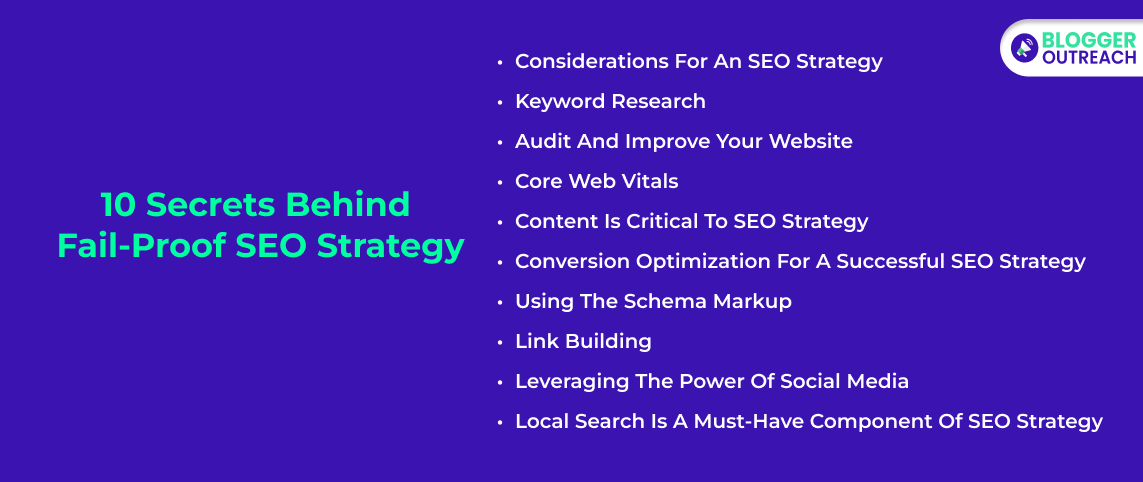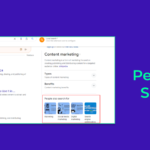Table Of Content [hide]
- 1 10 Secrets Behind Fail-Proof SEO Strategy
- 1.1 1. Considerations For An SEO Strategy
- 1.2 2. Keyword Research
- 1.3 3. Audit And Improve Your Website
- 1.4 4. Core Web Vitals
- 1.5 5. Content Is Critical To SEO Strategy
- 1.6 6. Conversion Optimization For A Successful SEO Strategy
- 1.7 7. Using The Schema Markup
- 1.8 8. Link Building
- 1.9 9. Leveraging The Power Of Social Media
- 1.10 10. Local Search Is A Must-Have Component Of SEO Strategy
- 2 Conclusion
Some people believe that SEO is all about keywords!
Are you one among them?
If you’re a digital marketer or someone who has been here for a long time, you know that apart from keywords, there is much more to it.
Another thing you need to consider is that SEO tactics have changed over the years.
How do you keep yourself updated and perform what is needed right now in the ever-evolving SEO landscape?
Look, finding out what’s wrong with your SEO is not rocket science.
Here you need to design a fail-proof SEO strategy.
Unfortunately, when it comes to building an effective SEO strategy, marketers make the mistake of starting and ending with keyword research. SEO strategizing involves so much more.
It is optimizing your website pages around topics and keywords within those topics, then building expertise to increase search engine visibility and rank well for opportunity keywords.
It is worth noting that not every business can use the same strategy and succeed. This is because there are so many variables, including industry, target audience, business goals, etc.
With that in mind, here is the ultimate guide to creating an SEO marketing strategy.
10 Secrets Behind Fail-Proof SEO Strategy

Do you want to devise a stellar SEO strategy that can take your business to new heights in 2024? If yes, then keep reading this article.
1. Considerations For An SEO Strategy
There are a few things you need to consider when drafting an SEO strategy i.e.
(i) Understanding The Business
Every business is an entity with unique characteristics. You need to know them if you hope to build a winning strategy.
- Company Vision: A vision statement is meant to inspire great ideas at all levels, even SEO marketing. If well-drafted, it could also aid your efforts.
- Core Values: Any business can only offer so much value to customers. The company’s core values will serve as your campaign parameters, ensuring you offer optimal value to consumers.
- Leadership: This often influences culture in the workplace, especially in small businesses. This may not be true for large companies. Regardless, you should spend time exploring leadership style and if it matches up to the core values.
- Weak Links: There are things that knock down the business at varying levels. What drives employees to drink? What challenges are they looking to overcome? And when knocked down, how do they get back up?
(ii) Determine The Optimization Goals
A goal-oriented SEO strategy needs to be SMART – Specific, Measurable, Achievable, Realistic, and Time-bound.
- Specific: Determine the what and why of your campaign.
- Measurable: What are the measures of success? Are you trying to make a certain amount of money by the end of 3 months? Do you want to increase website traffic? And if so, how many visitors do you want to engage with your site?
- Achievable: Ground your optimization goals in reality. While you cannot control Google rankings, you can use competitive data and sales history to your advantage. Leverage the information you gather from leaders, industry influencers, analysts, and merchandisers.
- Realistic: Consider the number of resources at your disposal when setting any goals. Your company should also be flexible enough to make proposed changes in time within the timeframe.
- Time-bound: It is important to set deadlines at each stage, and keep the responsible players accountable.
(iii) Understand The Target Audience
If you don’t know what your potential customers are looking for, you are in big trouble. It is important to not only go through the numbers but also understand the in-between stories. Analytical data like clicks and search volume provide credence to the larger theme. It makes it possible to create direction and better understand customer needs.
Use the data at your disposal to find out which areas of the business bring in more money. While at it, identify different audiences within the purchase circle. Platforms like AdWords and Facebook are goldmine consumer outreach. They provide a wealth of information that you could use to create personas for current visitors and those you don’t want to attract.
(iv) Competitive Landscape
Understanding the competition’s tactics allows marketers to learn from their wins and reinvent their mistakes for better results. There are dozens of tools for competitive analysis at your disposal including SEMrush, Ahrefs, MozBar, and BuzzSumo.
You can use these tools to look up the estimated traffic share and search volume of your competitors’ websites. Going through export data gives you a better idea of which topics draw the most traffic.
Backlink data offers the best illustration of what readers and topics inspire engagement. MozBar is one of the best backlink data providers. Filter top linked pages and dive into them to determine why they are so popular.
Social media is also a goldmine for competitive data. Users share content that they resonate with, and tools like BuzzSumo help dig through that information. Don’t be quick to dismiss influencers. Use BuzzSumo and similar tools to find out what they are sharing. Pay attention to the more specific themes shared by influencers when conducting competition research.
(v) Possible Challenges
Every company and industry has its own challenges, and it’s important to know them before going forward. Even with the best strategy, a 6-month ticket queue for the resources required can set you back. Ask questions pertaining to resource support, historic roadblocks, preference for bigger vs. short campaigns, etc.
2. Keyword Research
Keyword research is a crucial facet of SEO strategy and helps determine how your website is ranked on Google. This step involves identifying the keywords you want to rank for. Check out your competition and find out what keywords they rank for. It may even give you great ideas for your campaign.
Spend time with your marketing team brainstorming ideas. Resources like SEMrush and Google Keyword Planner come in handy during this stage. It lets you know how many people search for certain keywords and the level of competition.
It is worth noting that while some of the tools are free, they don’t offer as detailed information as paid platforms.
You’ll want to focus your attention on semantic search keywords. Such a keyword database offers great advantages including improved CTR, reduced bid amount, and increased quality score. Finding semantic keywords is not as easy as identifying SEO keywords. Fortunately, there are a few ways you can tip the scales.
When it comes to optimizing semantic keywords, it’s best to focus on trending topics. Tools like Google Trends will help narrow down the search. You should also consider studying social bookmarking tags. Dive in and learn how tags are used for bookmarking on social platforms. A quicker way to identify semantic keywords is to use the advanced search on Google.
The next step is to create keywords for conversion. You cannot use the hundreds of keywords identified during the research stage. Flipping through the export files is not efficient either. What you need to do is create a master file. Use it to sort keywords and get rid of the irrelevant ones. Assign the keywords to target pages.
You should think about tracking the targeted keywords. Factors that come into play at this point include organic visitors, exact match search, keyword diversity, and phrase match.
3. Audit And Improve Your Website
While difficult to accomplish on your own, this is the most important step. It is a thorough diagnosis of how your website looks in regards to SEO. Some of the things to look for include performance, links, local SEO, mobility, technical, content, and social media.
(i) Speed
Your website loading speed needs to be lightning-fast. Research shows that people leave websites that don’t load in less than 5 seconds. This is particularly true for mobile device users, who expect websites to load at warp speed.
Slower speeds will affect not only the number of visitors but also leads and conversions. Take advantage of Google’s Accelerated Mobile Pages (AMP), a tool specially designed to dramatically improve website speed.
(ii) Mobility
It sounds like a broken record, but your website should be mobile-friendly. Most people do Google searches on mobile devices. And while the specifics vary depending on the industry, failure to have a mobile-friendly website is not an option. Rather than create a separate mobile website, invest in a responsive theme.
(iii) Fluid Site Architecture
Websites should be built for readers rather than search engines. They still need to be effective for search engines, just not at the expense of user experience. Users should be able to seamlessly move through your site. This means having simple navigation.
Good site architecture makes it easier for search engines to discover and index pages. It helps increase overall website authority, a critical factor for Google ranking. Additionally, effective architecture spreads link equity throughout your website. This, in turn, builds overall website authority.
(iv) Micro Technical Issues
Now that you are done with the big three, it’s time to fix smaller technical issues that may have a negative impact on user experience. These include thin content, broken links, 404 errors, duplicate content, and redirect issues.
Conduct A Thorough SEO Audit, Covering The Following;
- Page-level analysis.
- Citation analysis.
- Keyword analysis.
- Technical analysis.
- Link analysis.
- User experience analysis.
- Competitor analysis.
4. Core Web Vitals
In SEO terminologies, core web vitals is the practice of gauging the user experience on your website. There are three core web vitals:
(i) LCP: Largest Contentful Paint
LCP tracks the loading time of a website. In simple terms, starting from clicking a link to actually viewing the content, how much time a website takes is part of the LCP.
As Google considers page loading to be the most important aspect of user experience, you can’t afford to take it lightly.
(ii) FID: First Input Delay
FID gauges the activities on your page. How much time it takes to perform a specific task comes under FID. For example, the time taken to submit a form, move to another page, etc.
Using a responsive, lightweight theme can help you to improve your website’s speed.
(iii) CLS: Cumulative Layout Shift
CLS tracks visual stability. If the elements of your website move around while loading the page, it negatively impacts your website’s experience. Higher CLS is detrimental to your website’s experience.
5. Content Is Critical To SEO Strategy
You are in big trouble SEO-wise if you have not updated your website since it went live. Good content is crucial to SEO marketing. It gives readers a reason to keep returning, increasing traffic and popularity. Things to consider while creating content for SEO.
(i) Relevance
Relevance is the most important factor for SEO content. Content must be relevant to the topic or industry in which the business operates. It must also be related to the target audience that the business is trying to reach with its SEO strategy. Make sure you place your keywords contextually without hampering the flow of the article.
(ii) Authority
Authority is another key element of quality content for SEO. Experts in the field should write good content. It should also be backed up by research and include references to reliable sources.
(iii) Legibility
Content should be easy to read and understand and written in a style that resonates with the target audience. Content should also be optimized for mobile devices, as most people now access the web from their phones or tablets. Remember to use emphasis tags like heading tags, bold, and italics.
(iv) Quality
The content should be high quality, relevant and recent. Depending on your budget, you could fine-tune your writing skills or hire outside help for this task. Target a specific keyword for every page, and use those keywords in blog posts.
(v) Updated Content
Be sure to post regularly since updated content is a sign of relevancy. Dwell time is another factor worth considering. How long does a visitor spend on your site? Do they read the posts to the end or get bored halfway through? Fresh and newsworthy content encourages visitors to stay on your website for longer, thus improving dwell time.
6. Conversion Optimization For A Successful SEO Strategy
Until a few years ago, no one cared about conversion optimization. However, the cost of bringing visitors to your websites is high and will continue to rise.
Optimizing your website for conversions allows you to continue spending however you want on campaigns.
It involves understanding the customer journey and optimizing the website to maximize conversion rates. This entails optimizing website design, content and calls to action to ensure visitors take the desired action.
Additionally, conversion optimization is about understanding user behavior and ensuring you optimize the website for the best possible user experience.
By focusing on user experience, a website can improve the chances of a successful conversion.
Additionally, conversion optimization involves testing and analyzing different strategies to identify the most effective approach.
By regularly testing and tracking, businesses can ensure that they tailor their SEO strategies for the best user experience and maximum conversions.
Moreover, Solutions like Qualaroo help you create survey questions helpful towards optimization. Use the data collected to determine the required changes for your website.
Visitors are sensitive to those specific elements if the tests you run cause conversions to move dramatically up or down. That is a good thing. If that is not the case, consider moving on and testing other website elements.
7. Using The Schema Markup
One essential tactic for improving your website’s search engine exposure and performance is schema markup. It uses microdata to give search engines comprehensive information about your content so they can show rich snippets in their search results.
Users will find your listings more enticing and educational if these rich snippets contain extra content like reviews, ratings, events, goods, and recipes.
One of schema markup’s main advantages is its ability to raise click-through rates (CTR). Compared to a basic text result, enhanced search results containing visual components like star ratings, event dates, or product pricing are more likely to catch consumers’ attention and encourage them to click on your link.
By providing important information up front, you can improve user experience overall and increase traffic to your website.
Schema markup is flexible and works with many kinds of content. E-commerce websites, for example, have the option to annotate product pages with information like price, availability, and customer reviews.
Similarly, recipe blogs can employ schema to draw attention to ingredients, cooking hours, and nutritional information. In order to make sure that prospective attendees can quickly access critical information, event organizers might highlight event dates, locations, and ticket information.
Schema markup can be easily implemented on your website with the aid of tools like Google’s Structured Data Markup Helper, which makes improving your content for search engine exposure and user interaction easier.
8. Link Building
A key component of SEO strategy is building links that are highly relevant. But how do you find relevant links?
(i) Guest Posting
Are you looking to boost your website’s traffic and credibility?
Guest posting – also known as guest blogging – could be the solution. Guest posting is when you write for established, high-profile websites; you get a valuable link in exchange.
(ii) Broken Link Building
Get ahead of the competition with a link-building strategy that works! Scan industry-recognized blogs for any ‘404 broken links’ and use the opportunity to pitch them to replace the link with one that drives to a relevant page on your website. Easily build and boost your links with this effective strategy.
(iii) Emulating Competitors’ Backlinks
Backlinks are the key to getting ahead of the competition. To get ahead, you need to research and identify the websites from which your competitors are getting the most backlinks.
(iv) Leveraging Images As Link Baits
Using a visual element like an infographic makes your content more engaging. This will also give you a higher chance of getting links, as people are more likely to share infographic content.
Example
Let’s say you want to rank for “cat food.” The most relevant link would be a web page that ranks among the top 100 search results for the same keyword. The second most relevant page would rank among the top 1000 search results for “cat food.”
It’s best to point links to internal pages highly related to the targeted keyword. You’d want all of the links pointing to a page that shows different types of cat foods. This will accrue better results by linking to the homepage with random pet products.
9. Leveraging The Power Of Social Media
Using social media to its full potential may greatly improve your SEO plan and increase your online presence. You may expand your audience, increase website traffic, and create deeper connections by being active on different social media networks. Forget about simply pushing blog entries, videos, or infographics—what matters is building a meaningful relationship with your audience.
It is imperative that your SEO strategy incorporate social media. Likes, shares, and comments—interactions that indicate engagement and foster a community around your content—all add to the digital footprint of your business. Establishing a reputation as an authority in your field requires this kind of engagement.
Sharing relevant, high-quality information on a regular basis establishes your company as a reliable source. Your reputation increases along with the number of people who share your material and follow you, which amplifies your influence.
Write content specifically for each platform and your target audience in mind to optimize the effects of social media on SEO. Engaging questions, eye-catching headlines, and attractive images may pique interest and motivate individuals to take an active part.
By creating backlinks, a strong social media presence not only helps your SEO efforts but also keeps your target audience interested and engaged online.
10. Local Search Is A Must-Have Component Of SEO Strategy
Google Possum is an algorithm that affects how websites rank in the 3-pack and Local Finder. Its launch saw a multitude of changes in local search results. At least 64% of keywords saw some kind of change, and this is pretty dramatic. This means that Google Possum was a significant update that online marketers should be aware of.
This is particularly important for businesses whose target demographic is strictly within a certain geographical area.
Other Ways To Pay More Attention To Local Search Include;
- Diversifying local keywords you rank for.
- Updating you’re my Google Business Listing.
- Keep in mind that Google uses IP addresses when generating search results.
Conclusion
While not easy, creating a good SEO strategy can prove lucrative for your business in the long run. You just have to be patient and not try to rank for your favorite keyword without conducting some research.
The steps outlined above will put you on the path toward SEO marketing success. And as always, every marketing strategy requires perpetual maintenance to keep up with unfolding trends.
Read Also:








